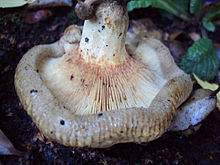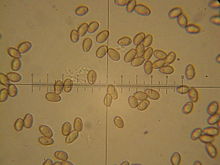Paxillus involutus
| Paxillus involutus | |
|---|---|

| |
| Scientific classification | |
| Domain: | Eukaryota |
| Kingdom: | Fungi |
| Division: | Basidiomycota |
| Class: | Agaricomycetes |
| Order: | Boletales |
| Family: | Paxillaceae |
| Genus: | Paxillus |
| Species: | P. involutus
|
| Binomial name | |
| Paxillus involutus | |
| Synonyms[1][2] | |
|
Agaricus contiguus Bull. (1785) | |
| Paxillus involutus mycorrhizal | |
|---|---|
| Edibility is deadly | |
Paxillus involutus, also known as the brown roll-rim or the common roll-rim, is a
A common mushroom of
Taxonomy and naming

The brown roll-rim was described by French mycologist
The genus was later placed in a new family,
Studies of the ecology and genetics of Paxillus involutus indicate that it may form a
Description

Resembling a brown wooden

The spore print is brown, and the dimensions of the ellipsoid (oval-shaped) spores are 7.5–9 by 5–6 μm. The
Similar species
The brownish colour and funnel-like shape of P. involutus can lead to its confusion with several species of
The most similar species are two once thought to be part of P. involutus in Europe. Paxillus obscurisporus (originally obscurosporus) has larger fruit bodies than P. involutus, with caps up to 40 cm (16 in) wide whose margins tend to unroll and flatten with age, and a layer of cream-coloured mycelia covering the base of its tapered stipe. P. validus, also known only from Europe, has caps up to 20 cm (7+7⁄8 in) wide with a stipe that is more or less equal in width throughout its length. Found under broadleaved trees in parks, it can be reliably distinguished from P. involutus (and other Paxillus species) by the presence of crystals up to 2.5 μm long in the rhizomorphs, as the crystals found in rhizomorphs of other Paxillus species do not exceed 0.5 μm long.[23]
Other similar species include Phylloporus arenicola, Tapinella atrotomentosa, and Tapinella panuoides.[26]
Ecology, distribution and habitat
Paxillus involutus forms
The presence of Paxillus involutus is related to much reduced numbers of bacteria associated with the roots of Pinus sylvestris. Instead bacteria are found on the external mycelium.[40] The types of bacteria change as well; a Finnish study published in 1997 found that bacterial communities under P. sylvestris without mycorrhizae metabolised organic and amino acids, while communities among P. involutus metabolised the sugar fructose.[41] Paxillus involutus benefits from the presence of some species of bacteria in the soil it grows in. As the fungus grows it excretes polyphenols, waste products that are toxic to itself and impede its growth, but these compounds are metabolised by some bacteria, resulting in increased fungal growth. Bacteria also produce certain compounds such as citric and malic acid, which stimulate P. involutus.[42]
Highly abundant,
Paxillus involutus can be found growing on
Australian mycologist
Toxicity

Paxillus involutus was widely eaten in Central and Eastern Europe until World War II, although English guidebooks did not recommend it.[22][30] In Poland, the mushroom was often eaten after pickling or salting.[15] It was known to be a gastrointestinal irritant when ingested raw but had been presumed edible after cooking.[28] Questions were first raised about its toxicity after German mycologist Julius Schäffer died after eating it in October 1944. About an hour after he and his wife ate a meal prepared with the mushrooms, Schäffer developed vomiting, diarrhea, and fever. His condition worsened to the point where he was admitted to hospital the following day and developed kidney failure, perishing after 17 days.[30][60]
In the mid-1980s, Swiss physician René Flammer discovered an
Poisoning symptoms are rapid in onset, consisting initially of vomiting, diarrhea, abdominal pain, and associated decreased blood volume.[63] Shortly after these initial symptoms appear, hemolysis develops, resulting in reduced urine output, hemoglobin in the urine or outright absence of urine formation, and anemia. Medical laboratory tests consist of testing for the presence of increasing bilirubin and free hemoglobin, and falling haptoglobins. Hemolysis may lead to numerous complications including acute kidney injury, shock, acute respiratory failure, and disseminated intravascular coagulation.[28][64][65] These complications can cause significant morbidity with fatalities having been reported.[64]
There is no antidote for poisoning, only
Paxillus involutus also contains agents which appear to damage
Despite the poisonings, Paxillus involutus is still consumed in parts of Poland, Russia, and Ukraine, where people die from it every year.[71][72][73][74]
See also
- List of deadly fungi
References
- ^ a b "Paxillus involutus (Batsch) Fr. 1838". MycoBank. International Mycological Association. Retrieved 29 June 2011.
- ^ a b "Agaricus adscendibus Bolton". Index Fungorum. CAB International. Retrieved 15 July 2011.
- ^ Bulliard, J.B.F. (1785). Herbier de la France (in French). Vol. 5. Paris, France: Chez l'auteur. pp. 192–240.
- ^ Batsch, August (1786). Elenchus Fungorum (Discussion of Fungi), Continuatio Prima (in Latin). Halle, Magdeburg, Germany: Apud Joannem J. Gebauer. p. 39.
- ^ Bolton, James (1788). An History of Fungusses, Growing about Halifax. Vol. 2. Huddersfield, UK: self-published. p. 55.
- ^ a b Gray, Samuel F. (1821). Natural Arrangement of British Plants. London: Baldwin, Cradock, and Joy. p. 611.
- ^ Rabenhorst, Gottlob Ludwig (1844). Deutschlands Kryptogamenflora (in German). Vol. 1 (2 ed.). Leipzig, Germany: E. Kummer. p. 453.
- ^ Fries, Elias Magnus (1838). Epicrisis Systematis Mycologici (in Latin). Uppsala, Sweden: Typographia Academica. p. 317. Archived from the original on 23 September 2015. Retrieved 15 July 2011.
- ISBN 3-540-66493-9.
- ^ Maire, René (1902). "Recherches cytologiques et taxonomiques sur les Basidiomycetes". Bulletin trimestriel de la Société Mycologique de France (in French). 18 (supplement): 165.
- ^ ISBN 0-14-063005-8.
- ^ Ziobro, G. (2012). Lampel, Keith A.; Al-Khaldi, Sufian; Cahil, Susan Mary (eds.). "Mushroom Toxins" (PDF). Bad Bug Book: Foodborne Pathogenic Microorganisms and Natural Toxins Handbook (2nd ed.). USFDA/Center for Food Safety & Applied Nutrition. p. 204.
- ^ ISBN 978-0-394-51992-0.
- ^ ISBN 0-89815-169-4.
- ^ ISBN 0-7167-2600-9.
- ^ ISBN 978-0-471-72761-3.
- .
- ^ PMID 18554888.
- ^ Fries, Nils (1985). "Intersterility groups in Paxillus involutus". Mycotaxon. 24: 403–10. Archived from the original on 23 September 2015. Retrieved 30 June 2011.
- .
- S2CID 21611651.
- ^ ISBN 0-222-79409-7.
- ^ .
- ISBN 0-521-56047-0.
- ^ ISBN 0-584-10324-7.
- ^ OCLC 797915861.
- ISBN 3-85604-230-X.
- ^ ISBN 0-7234-1576-5.
- ^ ISBN 0-8166-1407-5.
- ^ ISBN 3-8331-1239-5.
- ISBN 978-3-540-67025-4.
- JSTOR 2432861.
- doi:10.1139/b88-080.
- PMID 33874068.
- .
- S2CID 44534073.
- PMID 10832638.
- S2CID 24753264.
- PMID 17335505.
- doi:10.1139/m97-147.
- doi:10.1139/w98-035.
- doi:10.1139/b90-280.
- ISBN 978-93-8002-692-3.
- ISBN 962-201-556-5.
- ISBN 978-964-2725-29-8.
- ^ Demirel, K.; Uzun, Y.; Kaya, A. (2004). "Some poisonous fungi of east Anatolia" (PDF). Turkish Journal of Botany. 28: 215–19. Archived from the original (PDF) on 5 May 2005.
- ISBN 978-1-60223-058-3.
- ISBN 87-635-1277-7.
- ISBN 978-0-88192-935-5.
- ISBN 0-521-78910-9.
- .
- ISBN 0-231-05695-8.
- JSTOR 3761625. Archived from the originalon 23 September 2015. Retrieved 1 July 2011.
- ^ Kuo, Michael (February 2004). "Hypomyces chrysospermus". MushroomExpert. Retrieved 26 July 2011.
- ^ Cleland, John Burton (1976). Toadstools and Mushrooms and Other Larger Fungi of South Australia. Adelaide, Australia: South Australian Government Printer. p. 177.
- ISBN 0-86840-742-9.
- ISBN 1-872291-28-7.
- .
- ^ Palfner, Götz (2004). "Macrofungi from Chile". self. Archived from the original on 7 January 2007. Retrieved 14 July 2011.
- ISBN 0-442-21084-1.
- ISBN 978-1-60358-214-8.
- PMID 4059740.
- ^ S2CID 19567802.
- ^ PMID 7105997.
- PMID 5105189.
- PMID 8146866.
- PMID 2000656.
- PMID 12226995.
- S2CID 6905071.
- doi:10.1139/v02-194.
- PMID 30755235.
- ^ Arcimovič, Martin (8 November 2022). "13 deadliest mushrooms in the world (don't munch on these)". Medium. Retrieved 1 December 2023.
- ISBN 9788170354987.
- ^ "Brown Rollrim". Wild Food UK. Retrieved 1 December 2023.
External links
 Media related to Paxillus involutus at Wikimedia Commons
Media related to Paxillus involutus at Wikimedia Commons Data related to Paxillus involutus at Wikispecies
Data related to Paxillus involutus at Wikispecies
